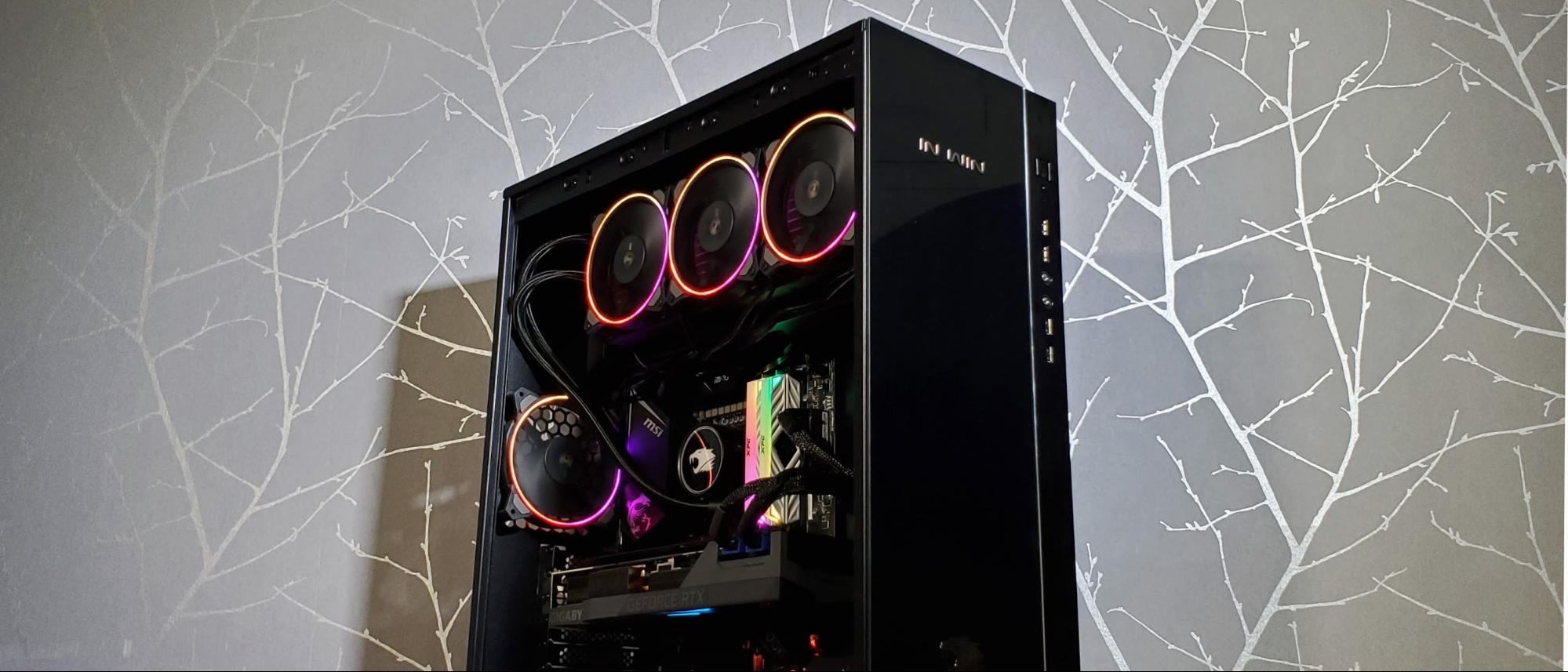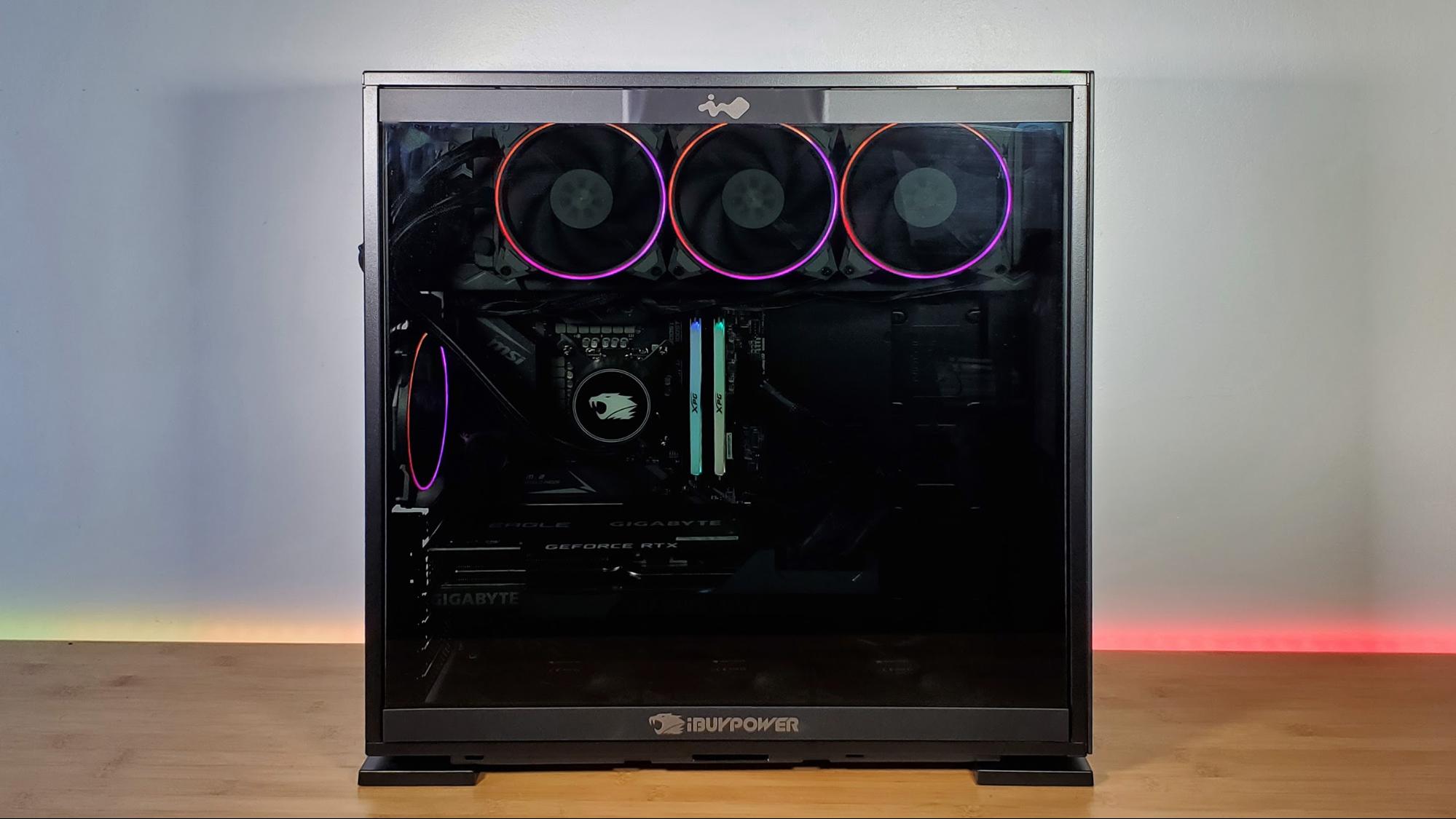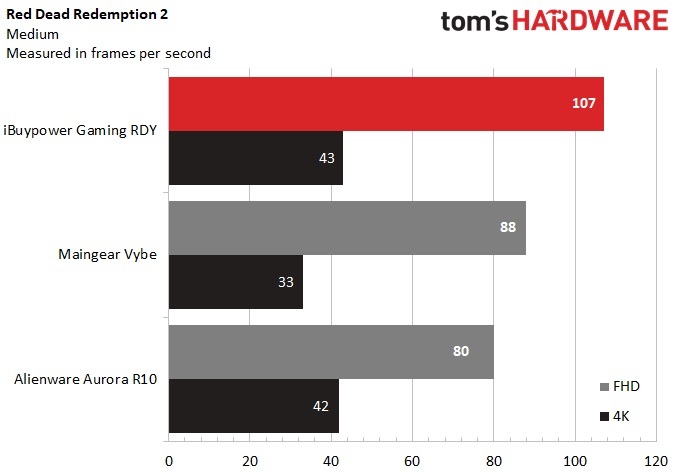Tom's Hardware Verdict
Buypower’s Gaming RDY IWBG207 pairs a 10th Gen Core i9 with an RTX 3080 for stunning gaming performance that easily bests previous-gen rigs that cost more. But like the Nvidia card that makes its performance impressive, it’s not easy to find in stock.
Pros
- +
Stunning gaming performance
- +
Reasonable price for what you get
- +
Lots of expansion options
- +
Three year warranty
Cons
- -
Cramped, middling storage
- -
Logo badge can cut you
Why you can trust Tom's Hardware
It’s a strange time to be reviewing high-end PC gaming products. Nvidia’s new Ampere-based RTX 3000 cards perform so well that, at least until AMD’s so-called Big Navi alternatives arrive, you shouldn’t really consider anything else. But due likely to a combination of bot-equipped scalpers and hardware / driver issues with very early units, it’s nearly impossible to buy an RTX 3080 or 3090 at anything approaching those cards’ MSRPs.
As is often the case soon after graphics card launches, one way to get a card without paying several hundred extra and getting nothing for it, is to buy a pre-built PC with the card inside it. Sure, you’ll pay a lot extra, but at least you get a whole PC in the process.

iBuypower’s RDY IWBG207 is one of those pre-built rigs, which pairs a top-end Core i9-10900KF CPU with an Nvidia RTX 3080 and wraps the system in an attractive (if boxy) In Win case. In terms of gaming performance, the results are predictively impressive. And at $2,199, the price is quite reasonable -- especially considering what you’d likely have to pay to get an RTX 3080 on its own at the moment without getting extremely lucky.
The main downsides with this iBuypower rig are cramped storage that isn’t as speedy as we’d expect given all the other high-end parts, and the fact that this system is also often out of stock. iBuypower (like everyone else these days) is struggling to get enough new Nvidia cards to meet high demand. If you’re after a high-end rig that will serve you well for several years to come, the RDY IWBG207 is well worth considering if you can find it in stock.
Just be careful when cleaning the front panel. Because at least in our review unit, the metal iBuypower case badge on the front of the case had sharp edges that snagged our finger more than once.
Specifications
| Processor | Intel Core i9-10900KF |
| Motherboard | MSI MPG Z490 Gaming Edge WiFi |
| Memory | 16GB Adata Spectrix DDR4 3200 MHz |
| Graphics | Gigabyte Eagle RTX 3080 (10GB GDDR6X) |
| Storage | 1TB Western Digital Blue SN550 PCIe NVMe SSD |
| Networking | Intel Wi-Fi 6 AX200, Bluetooth 5.1 |
| Front Ports | 2x USB 3.0 Type A, 2x USB 2.0 Type A, |
| Rear Ports | (Motherboard) 2x USB 2.0 Type-A, 4x USB 3.2 Gen 1 Type A, 1x USB 3.2 Gen2 Type C, 1x USB 3.2 Gen2 Type A, 2.5Gb Ethernet, 5x Audio jacks, Optical S/PDIF out |
| Video Output | (GPU) 3x DisplayPort 1.4a, 2x HDMI 2.1 |
| Power Supply | High Power 800W |
| Case | InWin 305 |
| Cooling | 360mm AIO, 4x 120mm In Win RGB fans, 3x 120mm iBuypower Fans |
| Operating System | Windows 10 Home |
| Extras | Zeus E2 mouse, Ares M1 RGB keyboard |
| Dimensions (HxWxD) | 18.9 x 19.2 x 8.5 inches / 480 x 487 x 215 mm |
| Price As Configured | $2,199 |
Components and Upgradability

If you’re after high-end gaming performance, it’s hard to argue against iBuypower’s pairing of an Intel Core i9-10900KF and (at least in our review unit) a Gigabyte Eagle RTX 3080 in this RDY IWBG207 system. iBuypower says the specific model of RTX 3080 card you get will vary, due to ongoing supply issues, but this system pairs the best gaming CPU with the best graphics card, for stunning performance. As part of the company’s same-day shipping RDY IWBG207 system, you also get a capable MSI MPG Z490 Gaming Edge Wi-Fi motherboard, a large 360mm AIO cooler to keep CPU temps under control, 16GB of ADATA XPG Spectrix RGB RAM clocked at 3200MHz, and a 1TB WD Blue SN550 SSD. All this is powered by an 800-watt High Power Gold PSU and housed in an attractive In Win 305 case.
There will no-doubt be those who nay-say High Power PSU, but it didn’t present any crashing or other performance / stability issues during our testing and gaming. And if you’re worried about stability long term, the system does come with a three-year standard warranty, which is better than you’ll get with many system builders. Other than that, my primary complaint with this system is the cramped 1TB of local storage. The SN550 drive itself isn’t very high-end for a system this powerful, but it’s good enough. Really, a lack of storage space is the main issue here. After you install a couple of today’s massive games alongside the included Windows 10 OS and some essential non-gaming software, you’re likely going to start yearning for more room for your files and programs.




It would have been easy enough for the company to toss in a 2TB hard drive and charge a bit more -- and that’s what iBuypower should have done here. But it’s also pretty simple to do so yourself -- or even better, add a second SATA SSD for games and a roomy hard drive for bulk storage. There’s a second spare M.2 slot on the motherboard and enough empty SATA connectors to add five more drives. The case has mounts for two 2.5-inch drives and two 3.5-inchers, so you could add a total of six drives without running into complications. There are also a few unused expansion slots on the board, but between the bulky three-slot GPU and the fans mounted on the bottom of the case, all that’s really available for use is the second x16 slot. Still, there’s oodles of expansion options in this system.


External connectivity is also ample with the RDY IWBG207. Aside from the four USB Type-A ports on the front of the In Win case (two 2.0 and two 3.0), the motherboard delivers eight more USB ports: four USB 3.1 Gen 1, two USB 2.0 and two USB 2.2 Gen 2 ports. The latter is 10Gbps for the Type-A port and 20Gbps (2x2) for the Type-C port.
There’s also a PS/2 port at the back, a pair of video ports (which you can’t use since the CPU lacks integrated graphics), 2.5Gb Ethernet and antenna attachments for the internal Wi-Fi 6 module, plus a standard outlay of six audio jacks, including SPDIF. About the only thing absent here that I would like to see is a front-panel USB-C port, but the system uses an off-the-shelf In Win 305 case which lacks that feature.
Get Tom's Hardware's best news and in-depth reviews, straight to your inbox.
Gaming and Graphics


The Core i9-10900KF isn’t new, but it’s still the fastest gaming CPU available (at least until AMD’s new Ryzen 5000 CPUs make it to market). But this is the first desktop we’ve tested with Nvidia’s new (and extremely hard to find at a reasonable price) RTX 3080 graphics card. We know from our testing of a few RTX 3080 cards at this point that its performance is very impressive. And the Gigabyte-branded 3080 in this iBuypower RDY system does not disappoint.




In Shadow of the Tomb Raider (highest settings), the top-end CPU and cutting-edge graphics card stomped the competition, delivering 22 more frames per second than the 2020 Maingear Vybe (which had the same CPU and a previous-gen flagship 2080 Ti) at 1080p, and approaching a 30% boost over everything else here at 4K.
On Far Cry New Dawn (ultra), the RDY’s edge wasn’t quite as strong, but the system still easily dominated, with a 1080p score of 122 fps, 10 frames ahead of the closest competition (again the Maingear Vybe), and 4K performance nearly reached triple digits.
On the Grand Theft Auto V benchmark (very high settings), the trend continued, with the RDY system delivering a class-leading 156 fps. At 4K things were closer, but the 3080 system still slipped by everything we’ve tested with previous-gen GPUs by at least 6 fps.
We don’t have a full set of test numbers for Red Dead Redemption 2 (medium settings), but compared to the Alienware Aurora and the recent Vybe, the RDY again sailed past the performance of these previous-gen powerful systems, and delivered 30 more performance than the Vybe at 4K. It’s been a long time since we’ve seen this much of a performance boost generation over generation.
We also subjected the iBuypower RDY system to our Metro Exodus gauntlet, in which we run the benchmark at the RTX preset 15 times to simulate roughly half an hour of gaming. On the test, the iBuypower machine ran the game at an average of 108 frames per second (fps), with almost no variation. The system started out the test at 107.84 on the first run and stayed above 108 on every other run, but never going higher than the peak of 108.35 on run seven.
During the Metro Exodus runs, the CPU ran at an average clock speed of 4.86 GHz and an average temperature of 62.9 degrees Celsius (145.2 degrees Fahrenheit). The GPU’s average clock speed was 1.8 GHz, with an average temperature of 64 degrees Celsius (147.2 degrees Fahrenheit).
Productivity Performance
The components in our configuration of the iBuypower RDY make for a powerful productivity machine as well as gaming, though if you can make use of lots of cores, it’s easier to recommend an AMD-based configuration. As we’ll see below, the 12 cores of Ryzen-3950X-based Alienware Aurora R10 ($3,629.99 at time of testing) often push it ahead of the 10-core 10900K-based RDY system.



On Geekbench 4.3, the iBuypower RDY edged past the Vybe and AMD-based CLX Ra from last year, but the extra cores of the Aurora give it an impressive advantage.
That was also true on our Handbrake video transcoding test, where the iBuypower RDY took 5 minutes and 30 seconds to convert a 4K video to 1080p. That’s just ahead of the Vybe and the HP Omen Obelisk, but the Aurora R10 is nearly two minutes faster.
Lastly, our comments earlier about the speed of the WD SN550 SSD are proven true in our file transfer test. It took the iBuypower RDY 42 seconds to transfer 25GB GB of files, which translates to 632 MBps. That’s faster than a SATA drive, but it’s easily the poorest showing among the competing machines in our group, and HP’s Omen Obelisk delivered almost three times that speed.
Software and Warranty
iBuypower sells the RDY with a three-year standard warranty, and we noticed nothing in the way of extra pre-installed software. Even the usual Windows bloat was kept to a minimum -- we only noticed Spotify and Office pre-populated in the Start menu.
Included Peripherals

On the one hand, it’s nice that iBuypower includes a set of peripherals in the box with the RDY system at all, something that’s increasingly rare with gaming rigs. Many buyers will have a set they may want to carry over from a previous gaming setup. But if you’re a first-time PC gamer, it’s nice to have the input devices to get you up and running. That said, what’s included here isn’t great, despite the RGB lights. The wired Zeus E2 mouse is OK, in that it has a nice ratcheting scroll wheel, an on-the-fly DPI adjustment button up top, side buttons and a shape and feel that doesn’t outwardly offend.

But the same can’t be said for the Ares M1 RGB keyboard. It has RGB-backlit keys (though the lighting isn’t very bright) and huge chunky media control (and email, search, and calculator) buttons. But this is a membrane keyboard, not a mechanical clacker. The feel of the keys is a bit squishy and the key caps have quite a bit of wobble. The frame is made of cheap-feeling (and looking) plastic that makes it easy to flex the whole keyboard in your hands. And those big, red media and software control buttons above the Function row -- oof! They look and feel like something from a kid’s keyboard from some previous decade. Seriously, when’s the last time you saw dedicated search and email buttons?
The keyboard feels more like a toy than something you’d want to use with a $2,000-plus gaming PC. Get yourself something better for your powerful new gaming rig. The best budget mechanical keyboards start as low as $41. No one should be using a 3080 with the Ares M1 RGB. Calling it a Fisher-Price keyboard would be an insult to the toddler-toy maker. The Ares feels more like Fisher Half-Price. At best.
Cost Considerations and Bottom Line

Given the ongoing scarcity of RTX 3080s and the exorbitant prices people are selling them for on eBay and elsewhere, it’s tough to put a concrete value on the parts that make up the iBuyPower Gaming RDY IWBG207. I’m sure more than a few people have paid over $1,500 for the RTX 3080 alone -- not that anyone should. But if you theoretically assume you could find a Gigabyte RTX 3080 for, say, $750, add $600 for the 10900KF (which is itself increasingly hard to find), throw in roughly $125 each for the power supply and case, $100 for the SSD, $180 for the motherboard, plus $220 for the 360mm cooler and 16GB of RGB RAM and you’re about at the $2100 mark. Then there’s the seven included fans (four of which are In Win RGB models) and the peripherals (such as they are). Clearly iBuypower isn’t adding a whole lot for its assembly and warranty service with this system. Given how tough it is to find an RTX 3080 in stock unless you’re willing to spend several hundred dollars over MSRP right now, getting a pre-built system is good option -- especially if the rest of your computing platform could also use an upgrade. Heck, even if you don’t need the rest of the system, you’re at least getting lots of perfectly good parts (which you could resell or use to upgrade), rather than paying over $1,000 just for a new graphics card that Nvidia says is supposed to sell for at or around $699.
But clearly many impatient 3080 hunters have also thought along these lines, as the iBuyPower Gaming RDY IWBG207 (and its 3090-equipped counterpart, the $3,149 IWRG205) have mostly been out of stock since launch. A company representative told us they expect their stock of 3080 cards to “stabilize” by the end of October 2020, but it’s unclear whether a stable supply means enough to meet ongoing demand. Perhaps by that time, AMD’s competing RX 6000 cards will offer up enough of an alternative to temper demand for Nvidia’s impressive new cards.
After a rough start with the Mattel Aquarius as a child, Matt built his first PC in the late 1990s and ventured into mild PC modding in the early 2000s. He’s spent the last 15 years covering emerging technology for Smithsonian, Popular Science, and Consumer Reports, while testing components and PCs for Computer Shopper, PCMag and Digital Trends.
-
ThatMouse Seems like really bad CPU radiator placement. The fans should be on top, not inside the case and up against the glass, and not right next to the hot PSU.Reply -
gg83 Reply
Right. It looks like air is blown through the radiator and into the space hodling the psu. Then the psu fan will draw that hot air through the psu and out the back? Can the psu components handle hot air?ThatMouse said:Seems like really bad CPU radiator placement. The fans should be on top, not inside the case and up against the glass, and not right next to the hot PSU.
